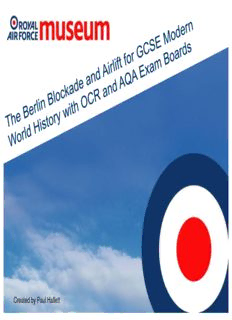
Berlin Airlift Resource pack PDF
Preview Berlin Airlift Resource pack
Created by Paul Hallett The National Cold War Exhibition and this resource pack will assist in the learning of GCSE Modern World History. As you enter the National Cold War Exhibition read the three information boards on the ‘Origins of the Cold War’. Created by Paul Hallett For AQA Topic 4: The Origins of the Cold War 1945–1960 Why did the USA and USSR become rivals in the years 1945–1949? (In the style of AQA Exam Board) Include the following aspects: • Ideological differences between capitalism and communism and their effects; • The Yalta and Potsdam Conferences; • The Truman Doctrine and the Marshall Plan; • The Berlin Blockade and Airlift. Created by Paul Hallett For OCR AO10 Core content (Previously A971) – Aspects of International Relations –The Cold War 1945-1975 Key Question 4. W ho was to blame for the Cold War? Why did the USA-USSR alliance begin to break down in 1945? (OCR Exam Board) Specified content includes the Yalta and Potsdam Conferences, Soviet control of Eastern Europe, the ‘Iron Curtain’, The Truman Doctrine and the Marshall Plan and the Berlin blockade and airlift and its consequences. Created by Paul Hallett • During WWII the USA, USSR and Britain had been allies in the war against Hitler’s Germany. As WWII entered its final stages the political leaders of the three great powers met first at Yalta and then at Potsdam in July 1945. Germany and Berlin was divided into four occupation zones. • The divisions between the USA and the USSR quickly appeared. The new USA President Harry Truman distrusted Stalin the Soviet leader. • The USA wished to see free and fair elections in all the countries of Europe while Stalin was determined to protect the USSR from any further aggression from the USA and its allies. Created by Paul Hallett • The USSR took parts of Eastern Poland into Soviet Russia and compensated Poland with parts of what had been Eastern Germany. They also imposed Communism on Poland. • The British and American zones of Germany were allowed to trade freely – this was known as the ‘Bizone’. Stalin realised that political unity would quickly follow from economic unity and indeed this did happen with the creation of West Germany from the U.S., British and French zones. Created by Paul Hallett • President Truman created a new post-war policy. Known as the ‘Truman Doctrine’ its aim was to prevent the further westward expansion of Communism. • Truman believed that Communism grew from poverty, misery and want. He therefore asked the American government to pour millions of U.S. dollars into the destroyed countries of Europe to allow them to rebuild as democratic nations. • The Western zones of Germany benefited from an influx of Marshall Aid. However, Stalin ordered those parts of Europe under Soviet control to refuse the aid offered by the USA. By 1948 the difference in living standards between East and West Germany and Berlin in particular were increasingly obvious. The East having less consumables and domestic items. Created by Paul Hallett • Truman secretly planned to introduce a new currency into the U.S., British and French sectors of Germany (and Berlin). Known as the Deutschmark this was introduced in 1948 to provide economic stability to Germany, a key stepping point to recovery. • For Stalin, already unhappy with the Marshall Plan which he saw as an attempt to bribe the countries of Europe towards a capitalist system, the introduction of the Deutschmark and the prospect of a separate West Germany led him to cut all road, rail and canal links to the western sectors of Berlin in June 1948. • This blockade was interpreted by the U.S. Government as the first stage of an attack on West Germany. • The West responded by organising an Airlift of supplies to West Berlin. Created by Paul Hallett (b) Explain why the Soviet Union blockaded West Berlin in 1948. [8 marks] (OCR Exam Board) Top tip – this type of question follows a message cartoon question and is compulsory. In this case the key skill is to explain a point or issue. Created by Paul Hallett (c ) The following were equally to blame for increasing Cold War tensions before 1950: i) Soviet control of eastern Europe ii) The Truman Doctrine and the Marshall Plan iii) The Berlin blockade and airlift How far do you agree with this statement? [10 marks] (OCR Exam Board) Top tip – here you need to assess all three factors and reach a supported judgement. While you can argue that all are equally important, a strong answer that assesses ‘how far’ you agree with this opinion would put the events into an order of importance and justify this judgement. Created by Paul Hallett
Description: